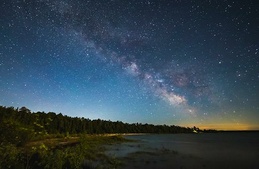The enduring Petoskey Stone
Sept. 13, 2006
Named after Native American Indian Chief Pet-O-Sega (or Petosegay), the Petoskey stone is as much a part of summers in Northern Michigan as are the beaches of Little Traverse Bay, fudge, ice cream, and the town of Petoskey, also named after the esteemed Chief. In 1965, the Petoskey stone was, in fact named the State Stone of Michigan.Many visitors to the area take home a Petoskey stone souvenir as part of their “Up North” experience, while most locals can claim a Petoskey stone or two lying casually around the house. Petoskey stones can be purchased in many shops in the region, of course - but the real prize is to discover one on the local beaches. Petoskey stones are fairly elusive to the unschooled searchers (and even to some who have been seeking the rocks for years), and that’s probably a large part of their draw - the treasure hunt. But there’s even more to the Petoskey stone than meets the unpolished eye.
Actually a fossilized coral (Hexagonaria percarinata, for the scientifically-minded), the stones’ previous lives were as part of a coral reef during the Devonian period (around 350 million years ago), back when much of Michigan was covered in a warm, shallow sea. Geographically, what is now Michigan was closer to the equator during that time, making the waters an ideal habitat for marine life; a typical Devonian reef may have been home to clams, cephalopods, trilobites, fish, and, of course, that aforementioned coral.
NEW CROP
About two million years ago, during the Pleistocene period, glaciers started moving in and sheets of ice pulled the stones from the bedrock. These stones were deposited in the Traverse Group lakebeds (and further onshore - you can sometimes also find them in gravel pits), where they can now be sought out, if you happen to be either lucky or diligent.
The best time to find the stones is during the early spring, after the ice has melted along the shore; as the ice breaks up and the winds push the ice around, it also pushes a new year’s crop of Petoskey stones towards the shore.
When dry, the stone resembles ordinary limestone, with just a very faint tracing of the hexagonal pattern that Petoskey stones are known for. But when wet - and especially when polished - the pattern becomes distinct and very striking in its various shades of brownish-gray. That’s why another great time to look for Petoskey stones is right after a rain, and why you’ll often see groups of people along the lakeshore on cloudy days, appearing as if they’re looking for something.
“People are very intrigued by the stones, as they’re only found this frequently in Michigan,” Petoskey’s Jennifer Shorter explains, “and they’re really only found on this side of the state, which makes them even more rare. Picking up a souvenir that’s millions of years old is really special.”
Shorter, whose family business is the Grandpa Shorter’s store in downtown Petoskey, says that their store sells literally thousands of Petoskey stones each summer - a boon for those who either didn’t luck upon one or simply didn’t feel like tracking down their own.
“We have several people who collect the stones for us, right from the middle of the bay,” Shorter continues, “and we are then able to offer the stones in many different forms. We’ve got pretty much every level of Petoskey stone, starting at $1.49 for a small stone attached to a descriptive card, all the way up to stones that are 15 to 20 inches across and cost between $300-400.”
Grandpa Shorter’s also offers the stones made into different gift items, such as jewelry, tie tacks, and drawer pulls.
HARD TO FIND
Sturgeon River Pottery (between Petoskey and Bay Harbor) is another local place that offers a wide range of Petoskey stone items.
“They can definitely be hard to find,” Sturgeon River’s Karen Andrews chuckles, “so we’re a great alternative for people who would still like to bring a Petoskey stone souvenir back with them.”
Andrews calls Petoskey stones a “portable memory,” and says their gallery also sells a large amount of the stones. “The stones are a nice way to reminisce about one’s vacation,” she says, “and whether you just want a raw stone or something more refined, we have many different items that incorporate the Petoskey stone.”
Both Grandpa Shorter’s and Sturgeon River Pottery offer the stones polished or, more interestingly, partially-polished, so that one side showcases the detailed hexagonal pattern, and the other side allows one to see the rough coral, much as the stone was when it was first pulled off of the coral reef.
If you’d rather buy a completely raw stone, you can polish it yourself using a rock tumbler, or, if you’re particularly ambitious, you can polish the stones by hand.
Since Petoskey stones are essentially made up of calcite, they are excellent candidates for hand-polishing, using a series of sandpapers (usually 220 to 400 to 600 grit as the stone gets smoother) and then a small piece of velvet and some polishing powder to give your Petoskey stone a beautiful sheen. And this isn’t a souvenir that will deteriorate over time - if Petoskey stones can last for 350 million years, you can bet they’ll still be around years from now for future generations to enjoy. Whether you’ve brought a few home or decide to spend a relaxing afternoon on a Northern Michigan beach, looking for this most popular and unique Up North geological souvenir is a lot of fun.
Trending

More than a Bookstore
Rachel Zemanek looked through the window of a vacant building in Cedar on a snowy day in February and knew it was the perfec… Read More >>
Three Cheers for Leland High School
Northern Michigan has no shortage of great schools, but as we head back for the 2025-26 school year, there’s one acade… Read More >>
2025 Cadillac Book Fest
Support your local and Michigan authors at the Cadillac Book Fest, Saturday, Sept. 6, from 10am-4pm! Head to downtown Cadill… Read More >>


